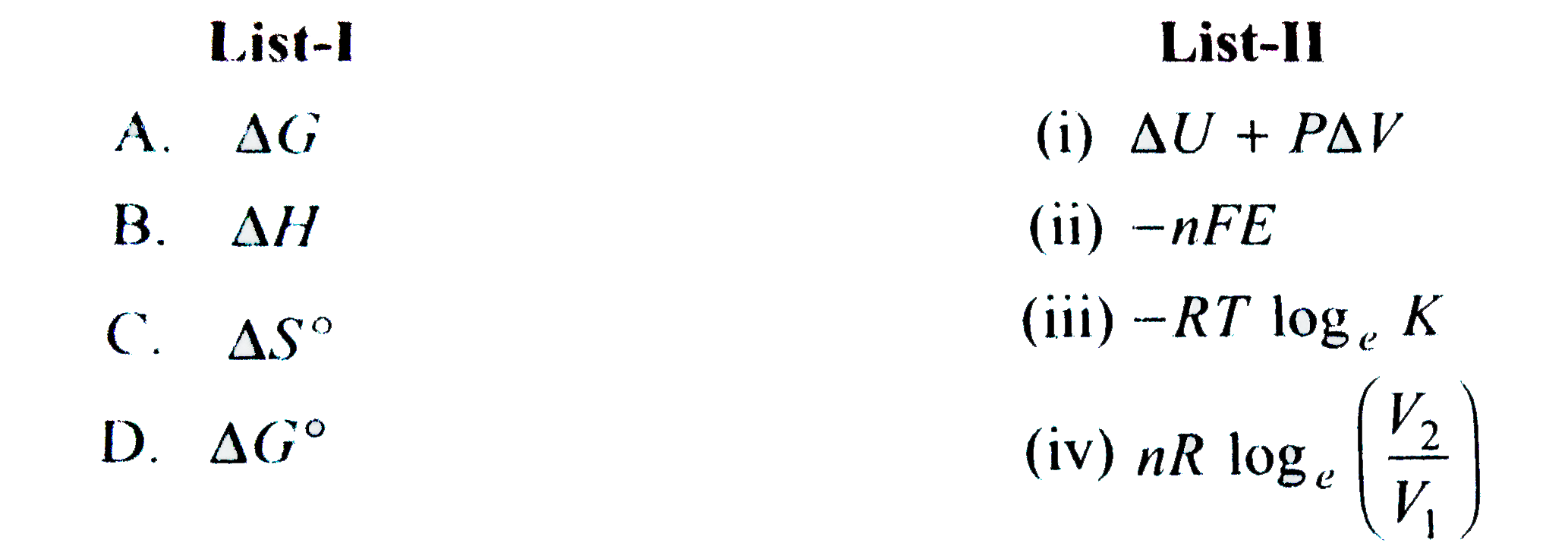The correct match is Solution in Telugu
The correct Answer is:A
Step by step video, text & image solution for {:("LIST - 1","LIST - 2"),("A) "Hp > HR,"1) Exothermic"),("B) "PDeltaV,"2 ) Total heat content"),("C) "E + PV ,"3) "DeltaH "is positive"),("D) "HR > Hp ,"4) Zero at constant volume"):} The correct match is by Chemistry experts to help you in doubts & scoring excellent marks in Class 11 exams.
Updated on:21/07/2023Topper's Solved these Questions
- CHEMICAL THERMODYNAMICSBook:AAKASH SERIESChapter:CHEMICAL THERMODYNAMICSExercise:OBJECTIVE EXERCISE - 2 (FIRST LAW OF THERMODYNAMICS)
Explore 10 Videos
- CHEMICAL THERMODYNAMICSBook:AAKASH SERIESChapter:CHEMICAL THERMODYNAMICSExercise:OBJECTIVE EXERCISE - 2 (E,H , HEAT CAPACITIES)
Explore 7 Videos
- CHEMICAL THERMODYNAMICSBook:AAKASH SERIESChapter:CHEMICAL THERMODYNAMICSExercise:OBJECTIVE EXERCISE - 1 (HESS LAW)
Explore 5 Videos
- CHEMICAL THERMODYANMICS Book:AAKASH SERIESChapter:CHEMICAL THERMODYANMICS Exercise:Questions For Descriptive Answers
Explore 28 Videos
- ELECTRON MIGRATION EFFECTS Book:AAKASH SERIESChapter:ELECTRON MIGRATION EFFECTS Exercise:QUESTIONS FOR DESCRIPTIVE ANSWERS
Explore 10 Videos
Similar Questions
A system absorbs 600J of energy and does work equivalent to 400J J of energy. The internal energy changes
View SolutionA gas absorbs 100 J of heat and is simultaneously compressed by a constant external pressure of 1.5 atm from a volume of 8.0L to 2.0L. The change in internal energy for the gas in Joules is (1L - atm = 101.32 J))
View SolutionHess.s law is based on
View SolutionHow does heat of neutralisation value change with the chemical nature of acid and base?
View SolutionHyperconjugation effect is also termed as 'no bond resonance'. Why?
View SolutionMatch list I with list II and select the correct answer: List I (Product) List II (Digit in the units place) (1827)16 1 (2153)19 (2) 3 C. (5129)21 (3) 5 (4) 7 (5) 9 A B C A B C (a) 1 4 3 (b) 4 2 3 A B C A B C (c) 1 4 5 (d) 4 2 5
View SolutionA person travels equal distances with speeds of 3 km/hr, 4 km/hr and 5 km/hr and takes a to a time of 47 minutes. The total distance (in km) is 2 b. 3 c. 4 d. 5
View SolutionMatch List I with List II and select the correct answer using the codes given below the lists: List I (Time) List II (Angle between hour hand and and minute hand of a clock) A. 1.10 p.m. 1. 20o B. 2.15 p.m. 2. 2212o C. 8.40 p.m. 3. 24o 4. 25o 5. 30o A B C A B C (a) 4 2 1 (b) 4 3 2 (c) 5 2 1 (d) 4 3 2
View SolutionIf a+b+c=n then match list 1 with list 2
View SolutionMatch the following lists {:(,"List -I",,"List II",),(A,"Ethlene",1,"Natalite",),(B,"Acetylene",2,"Preservative",),(C,"Ethanol",3,"Hawker's lamp",),(D,"Diethyl ether",4,"Drug",),(,,5,"Polyethlene",):} Correct match is:
View SolutionIf a,b,c are in HP,b,c,d are in GP and c,d,e are in AP, than show that e=ab2(2a−b)2.
View SolutionMatch the List I with List II and select the correct answer using. The code given below the lists.
List I List IIAPressure1inertBXe2Charles lawCPV=Constant3Pascal4hot air balloon4Boyle's law
View Solution ltBrgt Match the physical changes in List-I with their relations given in List-II:
ltBrgt Match the physical changes in List-I with their relations given in List-II:
View Solutionsin^(2) A/2, sin^(2) B/2, sin^(2) C/2 If s are in HP then a, b, c are in HP.
View SolutionMatch List I with List II and select the correct answer:
List I(ion)1List II (Shapes)AICl−21LinearBBrF+22PyramidalCCIF−43TetrahedralDAICl−44Square planar5Angular
View Solution